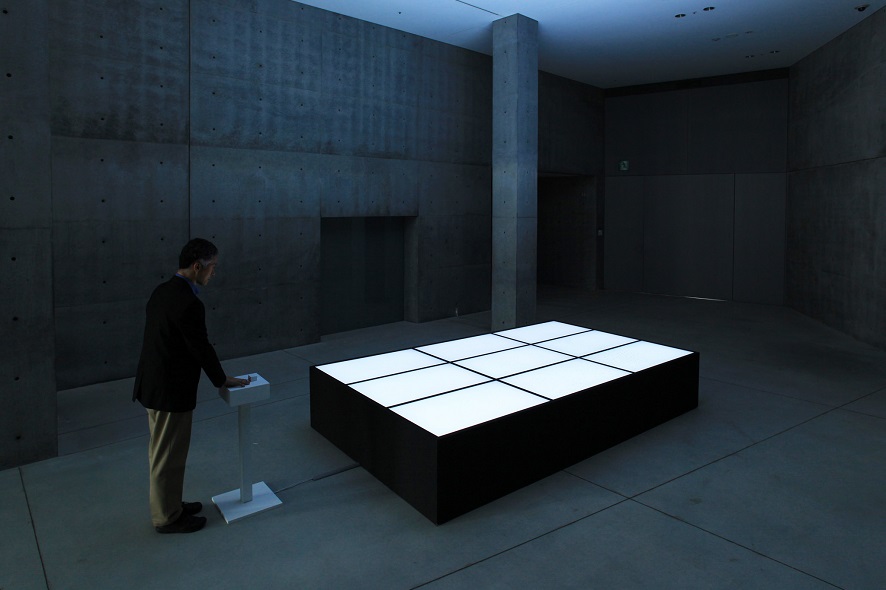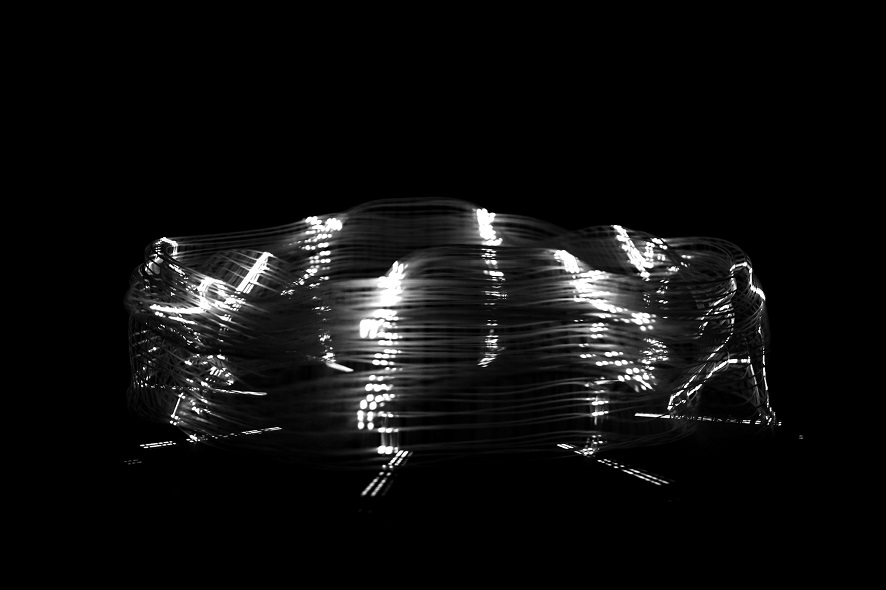The 2017 Ars Electronica Festival concluded over two months ago, but a few of the outstanding attractions showcased in PostCity are now being reprised in the Ars Electronica Center. In this interview, Ars Electronica producer Kristina Maurer tells us which works are making the move from the media art festival to the Museum of the Future, the reasons why they’ve been chosen, and what other new features await visitors to the Ars Electronica Center this autumn.

“Pool of Fingerprints”. Credit: Yuichiro Tamura
Once again this year, works from the Ars Electronica Festival are going on exhibit at the Ars Electronica Center. Which ones were selected?
Kristina Maurer: During the annual festival, we’re constantly on the lookout for fascinating art projects that we’d like to give more people a chance to see after the five-day conclave is over. One of this year’s choices is “Pool of Fingerprints” by a Japanese media art duo named Euclid (Takashi Kiriyama and Masahiko Sato). This work consists of an interface that lets installation visitors release their fingerprints into a pool displayed on a monitor. At the interface, the user puts his/her index finger on a scanner, and releases the resulting image into the pool, where it mixes in with other users’ fingerprints. However, if the user then starts to feel uneasy at the thought of a unique feature of his/her identity out there swimming around and remaining behind even after s/he leaves the installation, there’s a chance to retrieve the scanned image back into the interactive terminal. On the other hand, visitors can also decide to leave a little part of themselves in the Ars Electronica Center, where it will live on with other fingerprints.

Credit: Martin Hieslmair
The other works are also by a Japanese artist, Akinori Goto. What are his themes?
Kristina Maurer: Akinori Goto works with projections and 3-D printing, using these media to create kinetic sculptures. In “Sculpture of Time” the artist elaborates on the interrelationship between movement and time, and visualizes the passage of time in terms of motion. Hidden in his delicate 3-D printed objects are figures that don’t become visible until the object is set in motion and light is projected onto it.
Goto often transforms something human into something digital and then back again into something physical. Is that the case in these works too?
Kristina Maurer: Yes, that’s an excellent description of his approach. For example, to create his sculptures, he works with actual dancers, sketching their moves and transferring these forms into a 3-D print. Thus, the human form initially vanishes into a 3-D printed object, only to reappear as a result of motion and the projection of light. One of the three works that we’re now exhibiting visualizes this process beautifully—one sees both the video of the dancers on whom the sculpture is based as well as the sculpture itself, so one gets an impression of how Akinori Goto develops these fascinating works.

Credit: Tom Mesic
Why were these two artists selected for the Ars Electronica Center?
Kristina Maurer: As we go about selecting works from the festival, we always seek interesting thematic tie-ins to the other exhibits on display in the Center. And that’s why we decided to go with the new projects by Euclid and Akinori Goto. “Pool of Fingerprints” raises fascinating questions about how we deal with our body and our identity. What does it mean for me when I leave behind my fingerprint in a public space? How do I treat this precious biological information pertaining to my body? Akinori Goto’s works offer a point of departure for a confrontation with boundaries and crossing the line separating the physical from the digital, but also with the subject of perception and optical illusion. Thus, there’s also a link between his three works and the exhibits in our BrainLab.

Credit: Robert Bauernhansl
There are also some brand-new works in the VRLab. What awaits us here?
Kristina Maurer: The substantive orientation of the VRLab is intentionally very open. Here, we want to develop infrastructure that’s as flexible as possible so we can offer wide-ranging insights into the latest developments in the area of virtual & augmented reality, and we can offer artists and project partners active in many different fields a platform for their virtual reality projects. In conjunction with the “De/Materialize” exhibition, we’re now working more intensively with local partners. Another exhibit that recently went on display is “INEO”, a graduation project by students at the Spengergasse Technical School in Vienna. INEO is about enabling senior citizens to get their feet wet in virtual reality. This application makes this medium accessible to people who’ve never encountered it before and who might have certain reservations when it comes to getting involved with high-tech. “Journey into the Human Body: The Heart” by two Linz-based digital agencies, Netural and Responsive Spaces, is a research project produced in cooperation with the Red Cross and Forte [continuing professional education center]. This is an initial prototype of a VR application meant to teach 4th graders about the human body. The project partners wanted to find out if VR can function as a tool for imparting knowledge in schools, and how such a tool could be adapted especially for biology instruction.

Credit: Florian Voggeneder
Will there be new artistic projects on display in the VRLab?
Kristina Maurer: LOGIN is a new interactive work by Jürgen Ropp, a student in Linz Art University’s Interface Cultures program. LOGIN situates us amidst a virtual plane in which we’re depicted as abstract data packets interlinked in a network. But the user isn’t alone there—people moving about in the vicinity of the actual installation likewise pop up in this virtual space. What the artist is dealing with here is the transition from the physical body into the digital domain, and with our interactions and the networked linkages in digital spaces.
VRLab will also be hosting two works of art from this year’s festival. “Training 2038” by Kitchen Budapest is an encounter with artificial intelligence; installation visitors are faced with morally and ethically challenging questions having to do with issues such as the use of drones in everyday life and the behavior of artificially intelligent vehicles in traffic. “Fight” by Memo Akten is about how our brain reacts when, in a virtual space, a person’s left and right eyes are each simultaneously fed different input. Plus, we’re intensifying our focus on augmented reality. Equipped with a Microsoft HoloLens, visitors can now test how an AR headset feels and functions amidst a real space overlaid with information.

Kristina Maurer is a producer and exhibition developer at the Ars Electronica Center. As executive producer, she develops exhibitions in cooperation with the artistic director, the education and cultural mediation department, as well as exhibition designers and architects, she produces exhibitions collaboratively with universities and scientific associates such as the European Space Agency, MIT Media Lab’s Tangible Media Group, and Linz Art University, and works closely with artists whose practice is situated at the nexus of art, science and technology.
To learn more about Ars Electronica, follow us on Facebook, Twitter, Instagram et al., subscribe to our newsletter, and check us out online at https://ars.electronica.art/news/en/.
